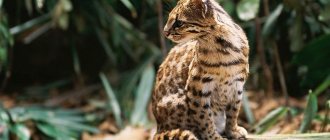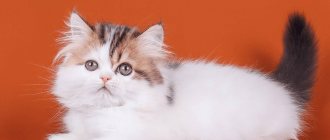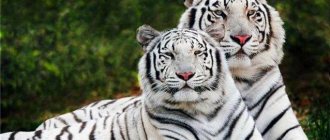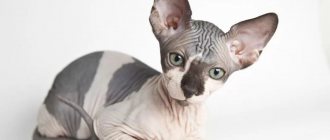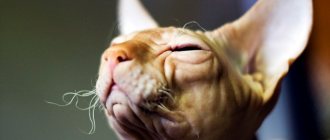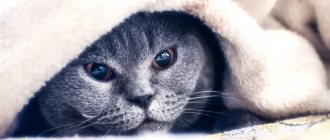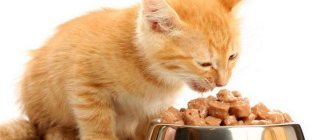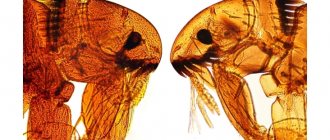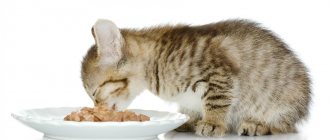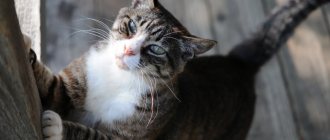External description
The Asian predator has an unusual color. The main background of the coat can be straw-brown, up to a dark grayish tint. The fur on the face is white, with black markings located on the forehead and cheeks. The belly and short legs are decorated with oval spots of charcoal color.
In babies up to six months old, the spots on the sides are solid, differing in brightness. In older animals, the spots take on the shape of an ellipse with light hair in the center. The back group of spots is slightly different in color intensity from the front; they are darker and more expressive.
The height of the animal, measured at the withers, ranges from 50-60 cm. The total length of the body (with head, but without tail) is 75-100 cm, the tail has the same length as the whole body - up to 90 cm. Weight of adult pets averages 20 kg. Females differ slightly in size from males, that is, the severity of sexual dimorphism is not observed.
The external features of clouded leopards are as follows:
- The eyes are beautiful yellow or gray-green, vigilantly watching for prey. The pupils, like all representatives of the cat family, are vertical.
- The length of the fangs varies from 3.5 to 4.5 cm, but there are also longer specimens. If we compare the length of the fangs and head, as well as the dimensions of the body, it turns out that clouded leopards have the longest fangs.
- Nose – has a pink color, sometimes there is black spotting.
- A characteristic feature of this animal species is its short legs. Rear limbs much longer than the front legs. Claws this wild cat's are retractable and of impressive size. The leopard of this species belongs to the digitigrade species.
Existing subspecies
It is customary to distinguish animals according to existing species:
- the nebulosa species is distributed in southern China, as well as in the eastern lands of Myanmar;
- macrosceloides is another subspecies found in Myanmar, also found in Nepal.
Until 1990, there was a Taiwanese subspecies, which is now considered extinct.
Habitat and distribution of the subspecies
Clouded leopards live on the southern slopes of the Himalayas in Nepal and Bhutan, as well as in the Indian northeastern regions. Wild cats with smoky colors can also be found in the south: Myanmar, Thailand, Vietnam, Malaysia.
Most often, clouded leopards can be seen in tropical forests located at least 3 thousand meters above sea level. These predators are capable of hunting not only on the ground, but also cope well with animals living in trees. Sharp claws and powerful limbs allow them to climb high up tree trunks. By the way, wild cats not only hunt on the tops of trees, but also rest.
Tropical forests are not the only habitat of clouded leopards. They can be found in mangrove swamps and swampy forests. Dry tropical forests and grasslands can also pose the risk of encountering predatory animals. Even coastal areas are not immune to leopard infestations.
What does a clouded leopard eat?
Photo: Clouded leopard Red Book
Like all wild cats, these animals are predators. It was once thought that they spent a lot of time hunting in trees, but recent research has shown that clouded leopards also hunt on the ground and rest in trees during the day. Animals hunted by predators include:
- loris;
- monkey;
- bear macaques;
- deer;
- sambars;
- Malayan lizards;
- muntjacs;
- wild boars;
- bearded pigs;
- gophers;
- palm civets;
- porcupines.
Predators can catch birds, such as pheasants. Fish remains were found in the excrement. There are known cases of attacks by these wild cats on livestock: calves, pigs, goats, poultry. These animals kill prey by sinking their teeth into the back of the head, breaking the spine. They eat by tearing meat out of the carcass, digging in with their fangs and incisors, and then sharply tilting their heads back. Often the animal sits in ambush on a tree, pressed closely to a branch. It attacks prey from above, jumping onto its back. It catches smaller animals from the ground.
Pregnancy and childbirth
It is not possible to observe mating in natural conditions, so all conclusions are drawn from observations of pets living under human supervision. Breeding in captivity often involves danger to the life of the female.
Males behave so aggressively during mating that they bite the female’s neck.
This usually happens if the male and female were kept in different enclosures before the act of acquaintance. When living together, matings are much more effective. This fact suggests that animals are monogamous, but scientists do not confirm such a hypothesis.
The process of copulation in a zoo most often occurs in the winter months or early spring. But this does not mean that animals do not mate during other periods. Matings are possible throughout the year. During flirting, the male bites the female's withers and begins sexual intercourse, while the female makes drawn-out sounds. Copulation occurs many times.
Under natural conditions, animals choose elevated areas for mating, from the slopes of which the moaning, drawn-out sound of a satisfied female echoes. From the moment of conception to delivery, it takes from 85 to 95 days, the timing is arbitrary and can shift both smaller and larger.
Pregnancy in a female is indicated by a rounded belly by the third trimester and enlarged nipples. There are from 1 to 5 babies in a litter, but most often 2 cubs are born in captivity. The weight of the baby when born is only 100-140 g, this figure also changes and depends on the number of babies in the litter. Newborn pets are born with their eyes closed; only after 10 days do they “see the light.”
Babies begin to walk around the 4th week after birth. 1.5 months after birth, little leopards perfectly master heights and climb trees without fear. The ability to hunt in babies awakens quite early. Already at 2-3 months they are capable of killing a bird, chicken or small rodent. Newborn babies are licked by their mother and fed with milk; this is the only nutrition that kittens receive from their mother until they are two months old.
At the age of two months, babies can already switch to meat, refusing mother's milk. The female begins to bring small prey from the hunt, which she feeds to the cubs. Until they reach ten months of age, children live under maternal care. She teaches them the wisdom of hunting and feeds them with her own prey. By the age of one year, animals are able to live separately and find their own food.
Pets reach sexual maturity at 24 months, but the figure can range from 20 to 30 months. In captivity, leopards produce litters no more than once a year. Male leopards are naturally selfish. After copulation, the couple separates, and only the mother is involved in raising the babies and feeding them. Males do not participate in the process of training their offspring.
Basic diet of wild cats
Carnivores are carnivores and feed on various types of birds, fish, small animals and rodents. All animals smaller than clouded leopards and living in the same territory as them can end up in their teeth. The exception is other predators that live on the same lands.
The main diet consists of:
- wild boars;
- gophers;
- macaques;
- loris;
- pork deer;
- fish from local waters.
Predators do not disdain domestic animals; they attack pigs, kids, calves, cats, and dogs. Their signature bite is on the back of the neck.
Nutrition
Little is known about the diet of clouded leopards. Like other felines, they are strictly carnivores. These cats are solitary hunters, they hunt birds, fish, monkeys, deer and rodents. Prey species: Argus pheasant, bear macaque, slow loris, silvery langur, sambar, pig deer, Indian muntjac, little deer, wild boar, bearded pig, Javan pangolin, Indochinese ground squirrel, and Himalayan civet. They also kill domestic animals, including calves, pigs, goats and poultry. Fish remains were found in the excrement of wild clouded leopards. This predator kills prey by biting the back of the neck.
Lifespan
The lifespan of predators is about 11 years. There are many dangers in the wild that can shorten the lifespan of clouded leopards. These include forest fires, human activity, leading to the destruction of natural habitats, as well as larger predators that can attack.
In zoos with good care and nutrition, pets live up to 15-17 years. No specific diseases that shorten the life of clouded leopards have been identified, since no research has been conducted in this area.
general characteristics
This representative of the feline genus occupies an intermediate position between large and small wild cats.
In most cases, the color of the animal is light yellow, but there are also individuals of a deep brown color. There are large spots of various shapes on the skin. The color of the spots can be uniform or slightly lighter in the middle. The color of the cat's chest and belly is light, with a small number of spots.
The average size of a clouded leopard (male in length, without tail) is from 80 to 100 centimeters. The tail is quite long, up to 90 centimeters. The animal weighs about 20 kilograms, but some individuals reach 30. At the withers, the animal is up to 50 centimeters high.
The mammal boasts magnificent fangs, the length of which is about 3.5 centimeters. For an animal of this size, these are quite large teeth.
The leopard's skull is elongated, its eyes are usually yellow, with oval pupils that are set wide on the muzzle.
Thanks to its long tail, the animal moves well through trees. The leopard's body is strong. The animal searches for food mainly at night, looking for prey from tree branches and catching up on the ground. The diet is based on wild pigs and deer; sometimes the animal manages to catch cattle. It also feeds on birds and monkeys, reptiles and fish, and porcupines. But in search of food, they can travel no more than 2 kilometers in one day.
The cat has excellent eyesight and can see perfectly at dusk. It is believed that animals have 6 times better vision than humans.
In the zoo, animals live up to 20 years, but how long they live in the wild is quite difficult to determine, since there is no opportunity to observe them in the wild.
Habits of predators
Spotted leopards hunt most often in the dark; their eyesight and dexterity allow them to do this. The special structure of the limbs and body allows predators to overtake prey right on the treetops. Short legs and a long tail help the leopard to masterfully perform real acrobatic performances.
These animals are capable of descending from trees upside down, hanging on branches, clinging to their hind limbs. Such physical characteristics make it possible to kill birds gaping on the branches. Trees serve as a place of rest and escape. In tropical thickets there is a special type of leeches that can ruin the sleep of wild cats, and tree branches are dry and relatively safe.
On the spreading crown you can escape from larger brothers that pose a threat to life. Leopards and tigers are not averse to chasing smoky animals through the forest, so trees are an excellent refuge for the latter.
Leopards of this species do not live in packs; they can be called solitary animals. To reproduce, the male finds a suitable female, and after her fertilization he disappears from sight. In the wild, you can see a female with cubs, which, after growing up, leave their native territory and settle in a new place.
The territory inhabited by 1 representative of this family is approximately 35 square meters. km. The area that is actively used is from 2 to 5 square meters. km. The habitats of females and males are approximately the same in size. In addition, the ranges of animals of the opposite sex partially overlap.
Natural enemies of clouded leopards
Photo: Animal clouded leopard
The main destroyer of mammals is humans. The animals are hunted for their incredibly beautiful skin. Dogs are used in hunting, driving down predators and killing them. Wild animals tend to live away from populated areas. As man expands his agricultural land, destroying forests and entering the habitat of this species, he, in turn, attacks domestic animals. The local population barbarously uses poisons to exterminate cats.
In the wild, leopards and tigers compete with our hero for food and can kill him to eliminate rivals. In such places, smoky cats are nocturnal and prefer to spend more time in the trees. Their camouflage coloring plays a good role; it is impossible to see this animal, especially in the dark or at dusk.
Threats to life in the wild
The main threat to the predator is humans. People track wild cats using packs of dogs. The skins of killed predators are used for sale, sewing, and as carpets. Wild predatory cats do not like to come close to human settlement areas; only natural disasters and lack of food can bring the clouded leopard to human habitation.
Clouded leopards live in the same areas as tigers, the common leopards. This proximity to large predators leads to the fact that medium-sized cats are forced to lead a nocturnal and arboreal lifestyle. In the absence of large predators in the territory, the clouded leopard descends to the ground and even into the water to find prey.
The spotted coat coloring is camouflage. Thanks to it, animals disappear into the branches of trees and become almost invisible to larger rivals and prey, which simplifies hunting.
Economic benefits and harm
Clouded leopards are a hot commodity on black markets. Due to the high cost of the skins of these animals, they are constantly hunted. In addition, in Asian countries, the skin of an animal gives high status to its owner.
Not only the skin is sold; the teeth, bones and claws of the predator are considered valuable. They are used for medicinal purposes, as well as amulets and amulets. In expensive restaurants in Asia you can find clouded leopard dishes on the menu. Exotic lovers purchase clouded leopards for personal use. They are tamed and domesticated.
Predators bring more than just benefits to humanity. Due to the shrinking of their habitat, these animals are forced to live close to humans. There are frequent cases of clouded leopards attacking domestic animals. Pigs, goats, as well as birds and other pets can be affected.
To combat predators, many rural residents use illegal methods. They scatter poison, which leads to the death of animals.
Culture
In 1992, Taiwan Post issued a stamp featuring a clouded leopard. On March 8, 2008, an envelope and stamp featuring a Taiwanese clouded leopard was also unveiled to coincide with the 21st Asian International Philatelic Exhibition in Taipei.
The clouded leopard was an important animal in the aboriginal culture of Taiwan. Leopard skins were used for clothing and religious ceremonies. The hunter who killed the clouded leopard was recognized as a hero. With the conversion of peoples to Christianity, the importance of the leopard decreases, but ownership of the clouded leopard skin remained an attribute of power and social status[7].
A representative of the Taiwanese aborigines wearing the skin of a Taiwanese clouded leopard. Photo from the beginning of the 20th century For the aborigines of the tribe, hand and hunting clouded leopards, on the contrary, was considered taboo. Local legends said that the spirit of this animal accompanies and guides their deceased ancestors, and the killing of a leopard brings misfortune not only to the hunter, but to the entire tribe.
Interesting fact
In 2005 , Taiwan introduced its own CM-32 8x8 infantry fighting vehicle, called the Clouded Leopard . It received this name in honor of the almost extinct Taiwanese clouded leopard. It is interesting that this project almost repeated the fate of the animal itself, as it encountered numerous problems ranging from legislative inertia, budgetary problems and design flaws.
The Army intended to order about 700-1,400 infantry fighting vehicles at an estimated cost of $2 million apiece to replace its aging armored personnel carriers. In 2007, production of the CM-32 began.
Video
Content Features
A clouded leopard as a pet is very rare. An active animal requires a spacious enclosure, well equipped and occupying a fairly large area. Reproduction in captivity occurs very rarely.
Smoky individuals are purchased from specialized nurseries that breed predators in captivity. The price for a cute wild cat starts at $25 thousand. In addition, it will take an impressive amount of money to feed her pussy every day, because she will not eat anything other than meat and fish dishes.
The purchase of a clouded leopard pays off only if it is placed in a zoo, where the price of a ticket and the huge number of visitors make it possible to provide the wild predator with everything it needs.
Little-known information about smoky predators
Clouded leopards are a little-studied population of the cat family. Therefore, many facts of their existence are unknown to a wide range of readers:
- The long fangs of clouded leopards resemble the teeth of saber-toothed cats, which have been extinct for a long time. Genetically, these animals are believed to be unrelated.
- On the island of Borneo, indigenous people used the fangs of wild cats as talismans. The chests of successful hunters were always decorated with trophies in the form of the fangs of a killed animal. They did not disdain skins either. Military uniforms were made from cat skins. The houses of the rich were decorated with rugs made from leopards.
- Residents of Thailand believe that the smoky cat of prey is their spiritual ancestor. It was the wild cats who had the mission to lead people to these beautiful places where they settled.
- Clouded leopards are wonderful zoo inhabitants. They never growl, so they don’t scare kids who come to interact with the animals. In captivity, a leopard seems to be a kind and sweet cat, and not a formidable predator capable of unexpectedly attacking at any moment. The absence of a growl is not a soft character, but the natural structure of the hyoid bone. Due to its ossification, the animal is not able to make menacing sounds. From its mouth you can hear good-natured purring and quiet purring, reminiscent of the sounds made by domestic cats.
- In Malaysia, the clouded leopard has another, more appropriate name - Tree Tiger. This nickname was given to the animal because it loves to rest on tree branches and climbs well even on the most dangerous branches.
Origin of the species and description
Photo: Clouded leopard
British naturalist Edward Griffith first described this feline in 1821, giving it the name Felis nebulosa. In 1841, Brian Haughton Hodgson, exploring the fauna in India and Nepal, based on a description of a non-Polish specimen, named this species Felis macrosceloides. The following description and name of the animal from Taiwan was given by biologist Robert Swinhoe (1862) - Felis Brachyura. John Edward Gray collected all three into one genus Neofelis (1867).
The clouded leopard, although it represents a transitional form between small and large cats, is genetically closer to the latter, belonging to the panther genus. Previously considered as one predator, it was split into two species in 2006.
Video: Clouded leopard
Collecting data on island mammals has not been easy. Animal skins stored in various museums around the world and animal excrement were taken as the basis for DNA research. According to these data and morphology, the range of Neofelis nebulosa is limited to Southeast Asia, the part located on the mainland and Taiwan, and N. diardi lives on the islands of Sumatra and Borneo. The result of the research also changed the number of subspecies. All nebulosa subspecies were combined, and the diardi population was divided into two:
- diardi borneensis on the island of Borneo;
- diardi diardi in Sumatra.
The two species diverged 1.5 million years ago due to geographic isolation as land communications between the islands disappeared, possibly due to rising sea levels or volcanic eruptions. Since then, the two species have not met or interbred. The clouded leopard of the Islands has smaller and darker spot markings and a darker overall coat color.
Even though the two types of smoky cats may look similar, genetically they are more different from each other than a lion from a tiger!
Animal protection
Due to the demand for animal skins, teeth, and bones, the population of these predators is sharply declining. Reducing the habitat also leads to irreversible consequences. The Taiwanese subspecies is considered extinct, and the remaining ones are on the verge of extinction.
By law, catching these cats is discouraged in the following regions:
- Myanmar;
- Taiwan;
- Vietnam;
- Bangladesh;
- India;
- China.
The United States has passed a law according to which the clouded leopard is classified as a rare species, therefore trade in its skins and other organs is prohibited in the United States.
The demand for beautiful fur gives rise to poaching. Hunters illegally capture and kill animals for the purpose of enrichment.
In addition, many farmers are unhappy with the unsafe proximity to smoky cats. Predators coming to the village are capable of destroying most of the population of pigs, goats and other living creatures. Therefore, farmers are waging an underground struggle against unpleasant neighbors. They use traps, baiting with dogs, poison and other illegal methods.
In 1975, the Convention on International Trade in Wildlife (CITES) decided to ban the sale of this subspecies of leopards in any form or even partially.
Population status
Many wild animals are in danger of extinction. They are listed in the Red Book. The clouded leopard is no exception. There are four subspecies of this animal in total. Each of them is distributed in a specific area:
- Southern China and Indochina;
- Taiwan;
- Nepal;
- Borneo.
The Taiwanese predator is considered extinct. This state of affairs is to blame not only for deforestation, but also for poaching. The animal's skin, as well as its fangs and bones, are valued on the market. Residents of Asia have long used them in their medicine. Some restaurants offer meat from endangered species.
These cats are becoming increasingly common in European zoos. If human activity regarding the extermination of predators does not stop, soon the clouded leopard can only be seen on video or in a cage.
